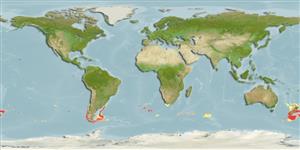>
Pleuronectiformes (Flatfishes) >
Achiropsettidae (Southern flounders)
Etymology: Neoachiropsetta: Greek, neos = new + Greek, a = without + Greek, chei = hands + Greek, psetta = grouper (Ref. 45335).
Environment: milieu / climate zone / depth range / distribution range
Ecologia
marino batidemersale; distribuzione batimetrica 165 - 1012 m (Ref. 119562). Deep-water
Southwest Pacific: southern New Zealand. Southeast Pacific: off southern Chile. Southwest Atlantic: Argentina, the Falkland Islands (Ref. 4417) and the Burdwood Bank. Southeast Atlantic: Discovery Seamount, off Cape Town (South Africa). Antarctic Indian Ocean: Prince Edward and the Crozet Islands.
Size / Peso / Age
Maturity: Lm ? range ? - ? cm
Max length : 57.0 cm SL maschio/sesso non determinato; (Ref. 5000)
Short description
Chiavi di identificazione | Morfologia | Morfometria
Spine dorsali (totale) : 0; Raggi dorsali molli (totale) : 117 - 139; Spine anali: 0; Raggi anali molli: 104 - 124; Vertebre: 62 - 66. Brownish grey; median fins darker; pelvic fin on eyed side with 7 rays, on blind side 6-7 rays (Ref. 4417).
Life cycle and mating behavior
Maturities | Riproduzione | Spawnings | Egg(s) | Fecundities | Larve
Heemstra, P.C., 1990. Achiropsettidae. p. 408-413. In O. Gon and P.C. Heemstra (eds.) Fishes of the Southern Ocean. J.L.B. Smith Institute of Ichthyology, Grahamstown, South Africa. (Ref. 5000)
IUCN Red List Status (Ref. 130435)
Threat to humans
Harmless
Human uses
Strumenti
Special reports
Download XML
Fonti Internet
Estimates based on models
Preferred temperature (Ref.
123201): 2.3 - 11, mean 7 °C (based on 240 cells).
Phylogenetic diversity index (Ref.
82804): PD
50 = 1.0625 [Uniqueness, from 0.5 = low to 2.0 = high].
Bayesian length-weight: a=0.01995 (0.00906 - 0.04395), b=3.01 (2.83 - 3.19), in cm total length, based on all LWR estimates for this body shape (Ref.
93245).
Trophic level (Ref.
69278): 3.9 ±0.62 se; based on food items.
Fishing Vulnerability (Ref.
59153): Moderate to high vulnerability (48 of 100).
